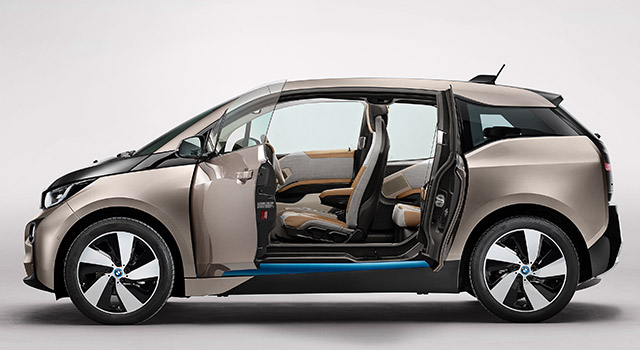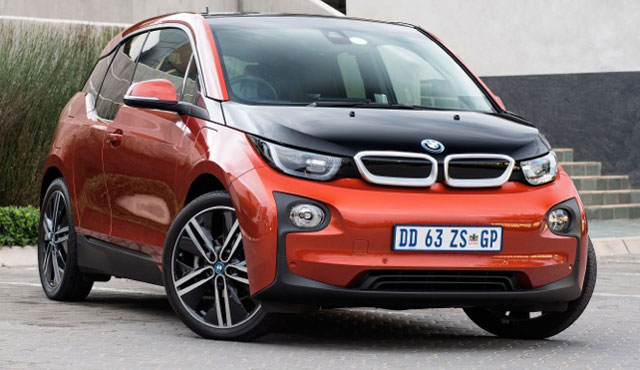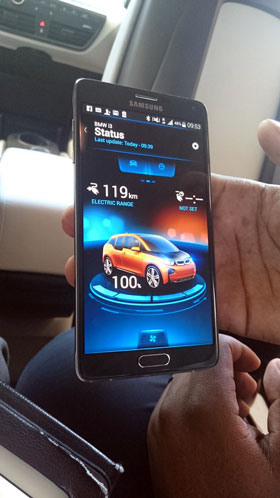
Pictures of BMW’s i3 don’t do justice to what is a truly modern urban electric vehicle. Being launched next to the stunning i8 sportscar doesn’t help either, as the inevitable comparison leads to the i3 being recognised as the much poorer second cousin, which isn’t really fair.
The i3 is BMW’s first all-electric mass-produced vehicle. With a claimed 160km range, it’s promising to redefine what a modern city vehicle should be (provided you don’t need to drive too far in it).
The absence of B-pillars — the central pillars between the front and rear doors — makes for a comfortable four-seater for a night on the town or commute to the office.
While roomy and spacious upfront, the vertically gifted may find the back seats a bit cramped. Aesthetically, the car is pleasing inside and out, with a carbon-fibre-reinforced plastic passenger compartment enhancing safety. It’s different enough to get you noticed, if that’s your intention.
The design and feel of the interior materials is futuristic and the i3 wouldn’t be out of place in the next Iron Man movie.
With 125kW on tap and a maximum torque of 250Nm, it delivers a surge of power that makes it feel as if it has a petrol engine under its bonnet.
Power is delivered to the rear wheels through a single-speed transmission, allowing it to accelerate with an uninterrupted flow of power to maximum speed. The car uses shift paddles on the steering wheel, something more common to sports models.
The i3’s electric motor is powered by a supercharged lithium-ion battery with a usable energy capacity of 18,8kWh. It won the 2014 International Engine of the Year award. The car has also been named the Green Car of the Year for its zero emissions, its lightweight design and the high percentage of sustainably produced materials used in its manufacture.
There are two main ways the car is charged. Selected BMW dealerships have rapid-charge stations that “refuel” the batteries with direct-current power, getting you an 80% charge in 25 minutes. Alternatively, owners can recharge at home much more slowly using grid power from Eskom.
The rapid charging stations are provided by Schneider Electric, and BMW says it is working with various industry bodies to develop standards for charging stations so that they can be used for other manufacturers’ vehicles in future.
Those hoping electric vehicles like the i3 will provide relief from the wallet-draining impact of the rising petrol price, there’s unfortunately still some way to go given the high upfront costs. At a recommended R525 000, the i3 is not for the budget buyer, especially considering that the home charging station costs a further R30 000.

BMW says almost all early adopters have opted for the installation of the home charging unit, known as the BMW i Wallbox.
The i3 also features a range extender option that comes at a premium of R70 000 over the base unit. This option offers a two-cylinder petrol engine that develops 28kW, maintains a minimum charge level and boosts the vehicle’s range to around 300km.
Internet on wheels
BMW’s connected car technology, called ConnectedDrive, is also standard in the i3.
Operating with a preinstalled Sim card, the i3 offers a number of services as standard, including Intelligent Emergency Call, which activates should the car be involved in a collision.

The caller is able to track the car’s location, how many airbags have been deployed and whether it’s had a side, front or rear collision.
Also included is an SOS feature, which the driver can activate should they witness an accident or need emergency assistance.
A Teleservices feature consistently sends technical data on your i3’s performance to your dealership and ensures you are contacted should your battery power fall below a certain level. Essentially, it shares service-related data with the workshop.
A standard feature on the vehicle is the Remote Services app, which can be downloaded to a an Apple or Android smartphone. The app allows the driver to check the charge status of the vehicle as well as find the nearest charging station. Not sure if you remembered to lock the car? No problem — the app allows you to lock (and unlock) the doors and windows and flash the headlights or blow the hooter from anywhere in the world where there’s an Internet connection.
The i3 also works with the Samsung Galaxy Watch and will also be compatible with the soon-to-be-released Apple Watch.
ConnectedDrive services also allow drivers to access news and weather forecasts as well as search and office functions. They can also check Twitter and Facebook, but preferably not while driving (Internet access won’t work if the car is travelling at speeds above 7km/h).
Concierge services are available, too, but cost of R3 200 extra for three years. They can be used to find places of interest such as restaurants or hotels and also allow you to access flight schedules in planning a journey.
ConnectedDrive includes Internet services and real-time traffic information that comes at a cost of R1 300 (for one year) and R1 900 (for three years) respectively. — (c) 2015 NewsCentral Media




